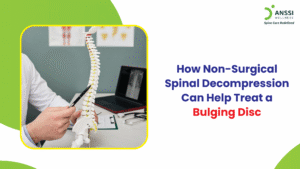A herniated disc can turn something as simple as sleep into a nightly struggle. When the soft inner gel of a spinal disc pushes through its tougher outer layer, it can compress nearby nerves, causing sharp pain, tingling, or numbness, especially in the lower back or neck. Rest is vital for healing, but for those with a herniated disc, the wrong sleeping position can worsen discomfort and delay recovery.
The good news is that by understanding how the spine works and adopting the right sleeping posture, you can ease pressure, reduce pain, and help your spine heal naturally.
Understanding the Challenge
The spine consists of 24 vertebrae cushioned by intervertebral discs that act as shock absorbers. When one of these discs herniates, the disc’s inner gel-like material (nucleus pulposus) leaks through a tear in the outer ring (annulus fibrosus). This herniation can irritate or compress spinal nerves, leading to pain that radiates through the back, neck, arms, or legs, commonly known as sciatica when it affects the lower spine.
Sleep is when the body repairs itself, and spinal discs rehydrate naturally after the strain of daily activities. However, improper sleeping positions can interfere with this healing process. When your spine isn’t properly aligned during sleep, additional pressure is placed on already-inflamed nerves and discs, increasing morning stiffness and pain.
Choosing the right sleeping posture and support can make a significant difference in both comfort and recovery.
The Importance of Sleeping Position for Spinal Health
Sleeping posture directly influences spinal alignment and disc pressure. If your spine maintains its natural S-curve while resting, the discs remain decompressed, allowing healing and nutrient exchange. On the other hand, sleeping in an awkward or unsupported position, such as twisting your neck or arching your lower back, can strain spinal structures.
For individuals with a herniated disc, finding a pain-free sleeping position is not just about comfort; it’s about preventing further nerve compression and supporting long-term healing.
Best Sleeping Positions for Herniated Disc Relief
Let’s look at the most effective sleeping positions recommended by spine experts.
1. Sleeping on the Back (with Knee Support)
Sleeping on your back is often considered the best position for people with a herniated disc, especially when the pain is in the lumbar spine (lower back). This position allows your spine to rest in its natural alignment and distributes weight evenly.
To enhance comfort, place a pillow or rolled towel under your knees. This slight elevation helps reduce stress on the lumbar curve, easing pressure on the discs. Keep your head supported with a medium-height pillow that aligns your neck with your spine. Avoid overly thick or flat pillows, which can cause strain.
2. Sleeping on the Side (with Pillow Between Knees)
If back-sleeping feels uncomfortable, try sleeping on your side with a pillow placed between your knees. This position keeps your hips, pelvis, and spine aligned, preventing twisting that can aggravate disc pain.
If your herniation is on one side, sleeping on the opposite side can help reduce pressure on the affected nerve. Choose a firm pillow that fills the gap between your shoulder and neck to maintain proper cervical alignment.
For lower back pain, slightly draw your knees toward your chest without curling too tightly. This posture helps reduce nerve tension and muscle stiffness.
3. The Fetal Position (for Lumbar Disc Herniation)
The fetal position, curling on your side with knees drawn toward the chest, can be particularly effective for people with lumbar disc herniation. It increases the space between vertebrae, reducing pressure on the discs and nerves.
To try this position, gently curl your body while lying on your side and tuck your knees toward your chest. Place a small pillow between your knees if needed. Be mindful not to curl too tightly, as excessive bending can restrict breathing and strain muscles.
4. Avoid Sleeping on the Stomach
Sleeping on your stomach is the least recommended position for anyone with a herniated disc. This posture flattens the natural curve of your spine, increases neck rotation, and adds unnecessary strain on the lower back.
If you can’t avoid stomach-sleeping, place a thin pillow under your abdomen or hips to support your spine’s natural curvature. Use a very soft or no pillow under your head to prevent neck strain. However, for optimal recovery, it’s best to gradually train yourself to sleep on your back or side.
Additional Sleep Tips for Herniated Disc Relief
Remember the following crucial factors.
1. Choose the Right Mattress and Pillow
A medium-firm mattress provides balanced support, allowing your spine to maintain alignment while reducing pressure on sensitive areas. Avoid overly soft mattresses that let your body sink too deeply or very firm ones that push against your spine.
For pillows, select one that supports the natural curve of your neck. Memory foam or contour pillows can help maintain neutral alignment.
2. Maintain Proper Posture When Getting In and Out of Bed
Many people worsen their disc pain by sitting up abruptly. Instead, roll onto your side, bend your knees, and push yourself up slowly using your arms. This reduces pressure on the spine.
3. Use Heat or Cold Therapy Before Bed
Applying heat can relax muscles and ease stiffness before sleeping. Alternatively, a cold compress can help reduce inflammation and numb pain. Choose whichever works best for your comfort.
4. Practise Gentle Stretches
Perform light stretching or yoga before bedtime to loosen tight muscles. Simple moves like the cat-cow stretch or pelvic tilt can relieve tension and prepare your spine for rest.
Non-Surgical Solutions for Lasting Relief
If pain persists despite proper rest and posture, non-surgical treatments can provide long-term relief.
Non-surgical spinal decompression treatment is one such option. It uses a specialised table to gently stretch the spine, creating negative pressure that allows herniated discs to retract naturally. This relieves pressure on nerves, improves disc hydration, and promotes healing, all without drugs, injections, or surgery.
Other options include physiotherapy, core strengthening exercises, and posture correction programs, which help stabilise the spine and prevent future injury.
About ANSSI:
ANSSI Wellness focuses on improving the quality of life for patients suffering from spinal issues, aiming to provide relief where other conventional treatments have failed. Through advanced Non-Surgical Spinal Decompression Treatment, ANSSI is committed to helping patients avoid surgery and recover in a safe, effective, and compassionate environment.
Connect with ANSSI Wellness on LinkedIn, Instagram, and Facebook for expert guidance.




